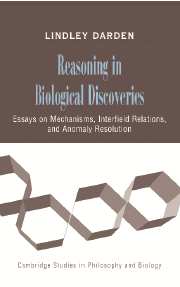 Reasoning in Biological Discoveries
Reasoning in Biological Discoveries Book contents
- Frontmatter
- Contents
- Long Contents
- List of Figures
- List of Tables
- Acknowledgments
- Introduction
- PART I BIOLOGICAL MECHANISMS
- PART II REASONING STRATEGIES: RELATING FIELDS, RESOLVING ANOMALIES
- PART III DISCOVERING MECHANISMS: CONSTRUCTION, EVALUATION, REVISION
- 12 Strategies for Discovering Mechanisms: Construction, Evaluation, Revision
- Bibliography
- Index
- References
12 - Strategies for Discovering Mechanisms: Construction, Evaluation, Revision
Published online by Cambridge University Press: 31 August 2009
- Frontmatter
- Contents
- Long Contents
- List of Figures
- List of Tables
- Acknowledgments
- Introduction
- PART I BIOLOGICAL MECHANISMS
- PART II REASONING STRATEGIES: RELATING FIELDS, RESOLVING ANOMALIES
- PART III DISCOVERING MECHANISMS: CONSTRUCTION, EVALUATION, REVISION
- 12 Strategies for Discovering Mechanisms: Construction, Evaluation, Revision
- Bibliography
- Index
- References
Summary
INTRODUCTION
The key ideas in the chapters in Part I on mechanisms and those in Part II on reasoning strategies now need to be integrated and extended. The chapters in Part I provide a characterization of mechanisms, based on an analysis of paradigm cases from molecular and neurobiology. Those chapters also begin a search for reasoning strategies for discovering mechanisms and for analyzing the role of mechanisms in understanding the relations among fields in biology. The chapters in Part II discuss reasoning strategies in scientific change, including the use of analogies, interfield theories, and abstract types of theories, as well as strategies for anomaly resolution.
Biologists often seek to discover mechanisms, as we have seen in previous chapters. The task now is to summarize and extend previous work on reasoning strategies for discovering mechanisms. When the discovery task is construed in an unconstrained way to find some sort of hypothesis, little guidance is available. It is not surprising that some philosophers relegated discovery to psychology, to the study of presumed “a-ha” discovery moments (Popper 1965). They had little to say about how to discover hypotheses or to revise them in light of anomalies. However, when the task is specified as the discovery of a mechanism, much can be said about how to proceed. The product guides the process of discovery, as stressed in Chapters 2 and 3.
- Type
- Chapter
- Information
- Reasoning in Biological DiscoveriesEssays on Mechanisms, Interfield Relations, and Anomaly Resolution, pp. 271 - 312Publisher: Cambridge University PressPrint publication year: 2006
References
- 1
- Cited by


